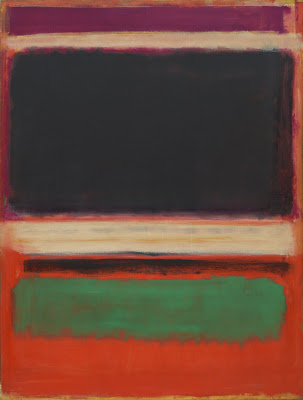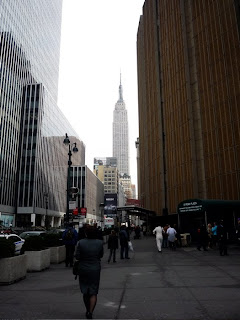Abstract Expressionism at The Museum of Modern Art (MoMA) and Beyond
(Exhibit closed.) REVIEW. Abstract Expressionist New York, a sprawling exhibition at MoMA that is drawn entirely from the museum's collection and fills the entire fourth floor plus two additional focus exhibits on the second and third floors, presents the opportunity to be surprised and see the world new again. Shifted to center stage, the paintings that once rocked the art world sixty years ago become important once more, not just another chapter, albeit an important one, in art history textbooks. Much time has ticked away since those boozy, smoky and chatty New York days that gave rise to the drips and the zips, and as most of the artists departed the big scene, a mythology about their lives and work overshadowed their real stories. But even as they became myths, new art movements and artists took their place. MoMA's exhibition includes a section about these pop upstarts - Johns, Oldenburg, Lichtenstein, Ruscha, Rosenquist, and above all, Warhol, waiting in the wings.
Jackson Pollock (1912-1956) is highly conducive for mythmaking because of his physicality, roots in the American West, and untimely tragic death, yet other biographies are equally fascinating. The mythologizing is an ongoing practice. Look at Mark Stevens and Annalyn Swan's popular 2004 biography of Willem de Kooning or the recent Broadway hit, Red, by playwright John Logan and starring Alfred Molina as the fierce Mark Rothko. While the vast MoMA exhibition, organized by curator Ann Temkin, invites a new look at the work through group displays, solo artist rooms, and thematic presentations, it's still difficult sometimes to see the work through the haze of hagiography.
In such an ambitious exhibit, one stretched almost to the breaking point, abstract expressionism becomes a rather slippery catchall term in light of its varieties on display. While Pollock might fit well under most meanings of the phrase, an artist like Barnett Newman points to minimalism, a rather different project. Still, by assembling the works close together, it's possible to see more unifying marks and themes than differences and even to feel the camaraderie that characterized the cultural moment in New York City in the 1940s, 1950s, and early 1960s. In galleries that showcase works by several artists, especially a strong room that gathers paintings by Willem de Kooning, Alfred Leslie, Joan Mitchell, Grace Hartigan, Larry Rivers, Sam Francis, Lee Krasner, and Jack Tworkov, the shared excitement of yet different artistic directions becomes most apparent.
While MoMA has taken the work out of storage for all to see, and yes, it's an impressive display, it does beg the question, "Are many great abstract expressionist works elsewhere?" Of course there are. As prized and necessary objects for their collections, representing the first most important school of American art to gain international importance, many museums own abstract expressionist paintings. While MoMA may house a formidable collection of abstract expressionist work, other museums could brag about significant works, too. The Muriel Kallis Steinberg Newman Collection at the Met, formed primarily in the early 1950s, has been recognized, according to the Met's site, "as one of the preeminent collections of Abstract Expressionist art in the country."(site) Jackson Pollock had his first solo exhibit at Peggy Guggenheim's Art of the Century Gallery, and the Guggenheim houses significant works by Pollock, including the early drip paintings, Alchemy and Enchanted Forest (1947), and Ocean Greyness from 1953. The latter is characterized by the museum as "one of Pollock’s last great works."(site) Even the Whitney Museum, in spite of its realist bent, began acquiring major works of abstract expressionism in the late 1950s. The National Gallery in Washington, D.C. owns Number 1, 1950 (Lavender Mist), that the museum describes as "one of Pollock's most important 'drip' paintings." (site) Regarding other artists, MoMA might have some excellent paintings by Mark Rothko, but the museum does not come anywhere near the National Gallery of Art's collection of 300 paintings and 600 drawings.
The list of museums with significant works of abstract expressionism extends to many other cities, especially those with rising economic and political clout in the postwar world. The Albright-Knox Art Gallery in Buffalo, NY became a major player in the 1950s and 1960s with commitment to the new art, hosting the major exhibition, Expressionism in American Painting, in the spring of 1952. In fact, the relatively recent Action/Abstraction: Pollock, de Kooning, and American Art, 1940–1976, an exhibition at the Jewish Museum in 2008, drew heavily on the Albright-Knox Art Gallery. Unlike MoMA's current exhibit, it didn't aspire to set forth a comprehensive chronology, but it did offer necessary comparisons and debates. Go beyond New York State and find excellent examples of abstract expressionist work in Dallas, Munich, Detroit, Chicago, St. Louis, Paris, Pittsburgh, and many other places.
These examples from other museums should not take away from MoMA, an institution with an established if sometime fitful relationship to the artists of the New York School, but it should add some pressure for them to offer a point of view or argument in its presentation. The satellite exhibits at MoMA make excellent arguments. Rock Paper Scissors, on the second floor, focuses on the various materials and mediums - wood, paper, etchings, crayon, etc. - that interested the artists, and the relationships of the physical materials to ideas such as the nature of premodern art or the subconscious. Ideas Not Theories: Artists and The Club, 1942-1962, presented on the third floor, puts the "New York" back into the exhibition by emphasizing the importance of meetings at The Club and the multi-media and inter-media nature of the New York School. Yes, John Cage and Morton Feldman are very much a part of this world. The fourth floor, the main show, Abstract Expressionist New York: The Big Picture, is presented with some visual exuberance, and includes more sculpture than usual, but with perhaps too much faith that the big paintings can speak for themselves. Fortunately, several of them do fine. They do not need wall text or even critic Clement Greenberg to explain to us their meanings.
Abstract Expressionist New York: The Big Picture
Through April 25, 2011 4th Floor
Abstract Expressionist New York: Rock Paper Scissors
Through February 11, 2011 2nd Floor
Abstract Expressionist New York: Ideas Not Theories: Artists and The Club, 1942-1962
Through February 28, 2011 3rd Floor
The Museum of Modern Art (MoMA), 11 W. 53rd St.
Abstract Expressionist New York: The Big Picture
Through April 25, 2011 4th Floor
Abstract Expressionist New York: Rock Paper Scissors
Through February 11, 2011 2nd Floor
Abstract Expressionist New York: Ideas Not Theories: Artists and The Club, 1942-1962
Through February 28, 2011 3rd Floor
The Museum of Modern Art (MoMA), 11 W. 53rd St.
Images courtesy The Museum of Modern Art.









I often turn to you for my NYC fixes, Teri, but when you combine NYC with art, I almost OD. Great, thoughful coverage of what sounds like a satisfying exhibit (and one I'd not heard of). I was relieved to see that the main show is up well into April. Maybe we'll get back in time for it.
ReplyDeleteThanks, Terry! I had to think about the exhibit, because in part, I remember fondly some of the AbEx paintings I've seen elsewhere. I know this is a good show but not a definite one.
ReplyDelete